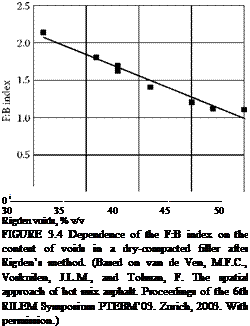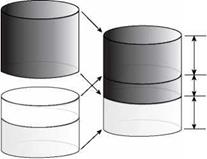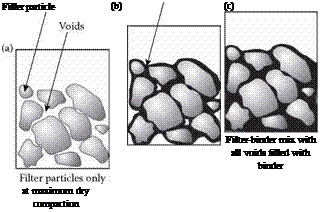Selection of a Binder
In countries where paving grade bitumens (unmodified) are used in SMA, it is usually assumed that the application of hard binders to ensure improvement in rut resistance is not necessary. It is generally accepted that, ensuring rut resistance should be accomplished by creating the correct mineral skeleton. So medium-grade binders are justified for use in SMAs, such as the popular 50/70 binder used in Germany or the 70/100 used in the Netherlands. A very soft binder like a 160/220 may be seen in Europe (e. g., in Finland); in very cold climate conditions, use of such a soft binder in not surprising.
The selection of a binder for an SMA wearing course is determined, on the one hand, by the temperature range over which the pavement is expected to perform and, on the other, by the expected traffic loads. The type of binder selected is limited by the local temperature conditions, which in most cases disallow for the application of excessively hard binders to prevent low-temperature cracking. In cold climate countries, softer PMBs are applied due to their high elastic recovery at low temperature. Some examples of these binders are presented in Chapter 5. A tendency to change the type of binder in consideration of the increase in traffic load—from paving grade, through multigrade, and up to a low penetration PMB—is clearly evident.
Despite particular emphasis being placed on securing rutting resistance mainly by the SMA skeleton, there is no doubt that the proper selection of a binder is an extra element supporting the stone skeleton performance. German research studies (Graf, 2006; Kreide, 2000) show that in most cases modified binder significantly increases SMA rutting resistance.
• SMA mastic consists of fine (or passive) aggregate, filler, stabilizer, and bituminous binder. Binder and filler together create mortar.
• One reason for using fine aggregate is to fill the voids among the coarse (active) grains and participate in their interlocking.
• The term filler denotes all the aggregate that passes through the limit sieve (0.063 mm in Europe or 0.075 mm in the United States). It is suggested that the properties of the whole filler fraction passing through limit sieve (i. e., added filler plus aggregate fines) be tested. Test results for the entire filler fraction may differ from the results of testing only the added fillers.
• An excess of filler leads to the stiffening of the mortar or mastic and an increase in its susceptibility to cracking.
• The correct filler-binder (F:B) ratios and mortar properties have an impact on the workability, compaction, and permeability of a given mixture. In
fact, formulating a universal F:B index is a kind of approximation; such an index should be defined for each filler individually.
• Fillers with high contents of voids (analyzed according to any Rigden’s method) should be used cautiously due to the insufficient content of free binder in a mortar, which results in stiffening the mortar.
• Adding hydrated lime at a rate of about 1.0-1.5% (m/m) is a positive solution, improving water resistance and the adhesion of the binder-filler to the aggregate.
• SMA binders can be divided into paving grade (unmodified) binder, PMB and special (most often multigrade) binder. Each of these types can be successfully used, providing the mix is well designed with properties appropriate for the traffic loading and local climate.
• The application of hard (low-penetration) paving grade binder (e. g., 35/50) for wearing courses is not recommended due to the high risk of low-temperature cracking.














